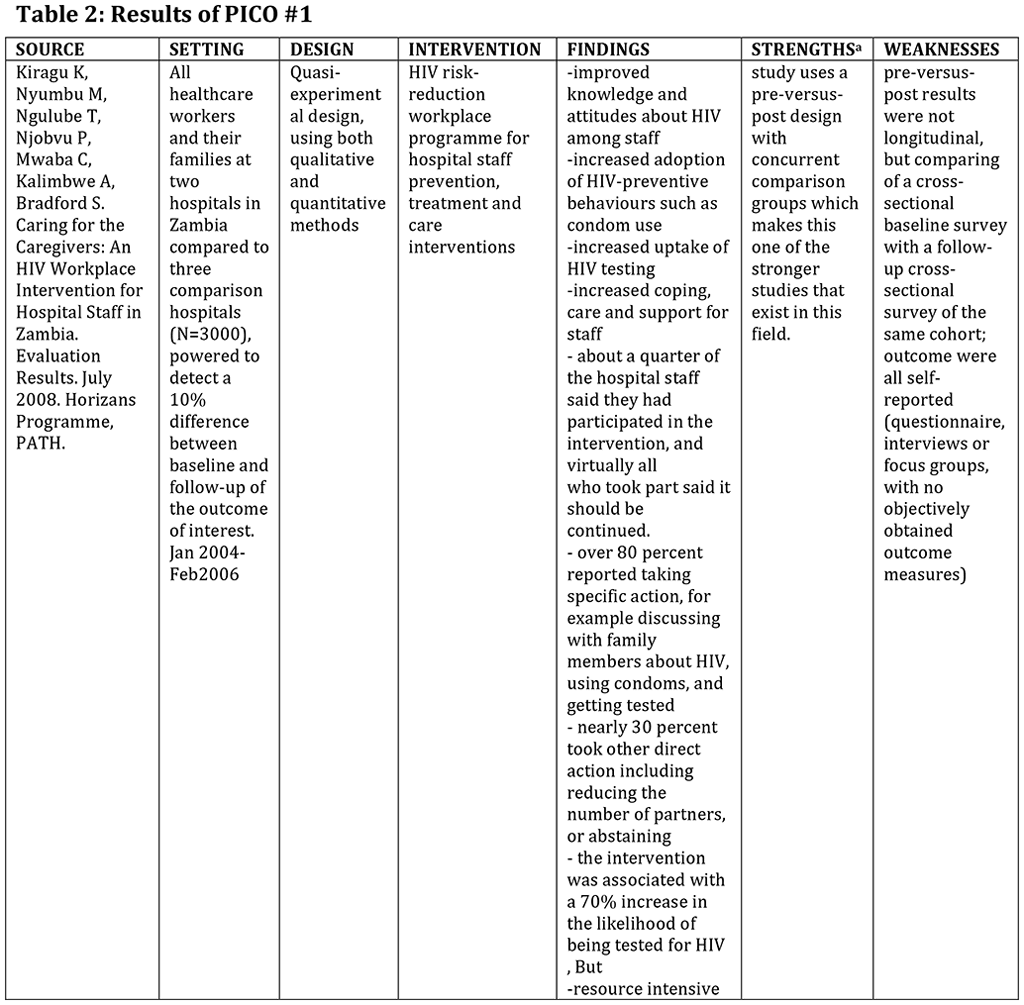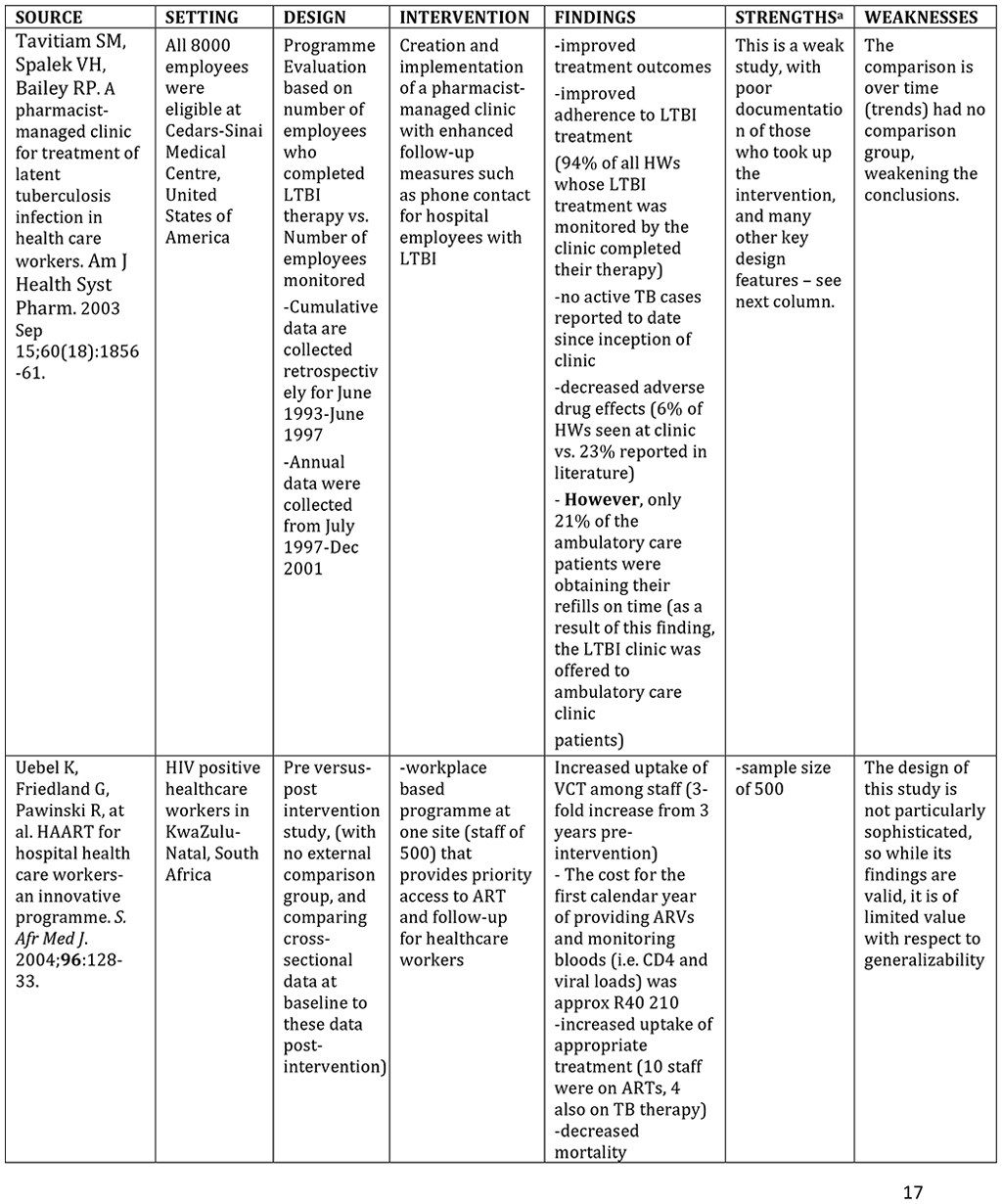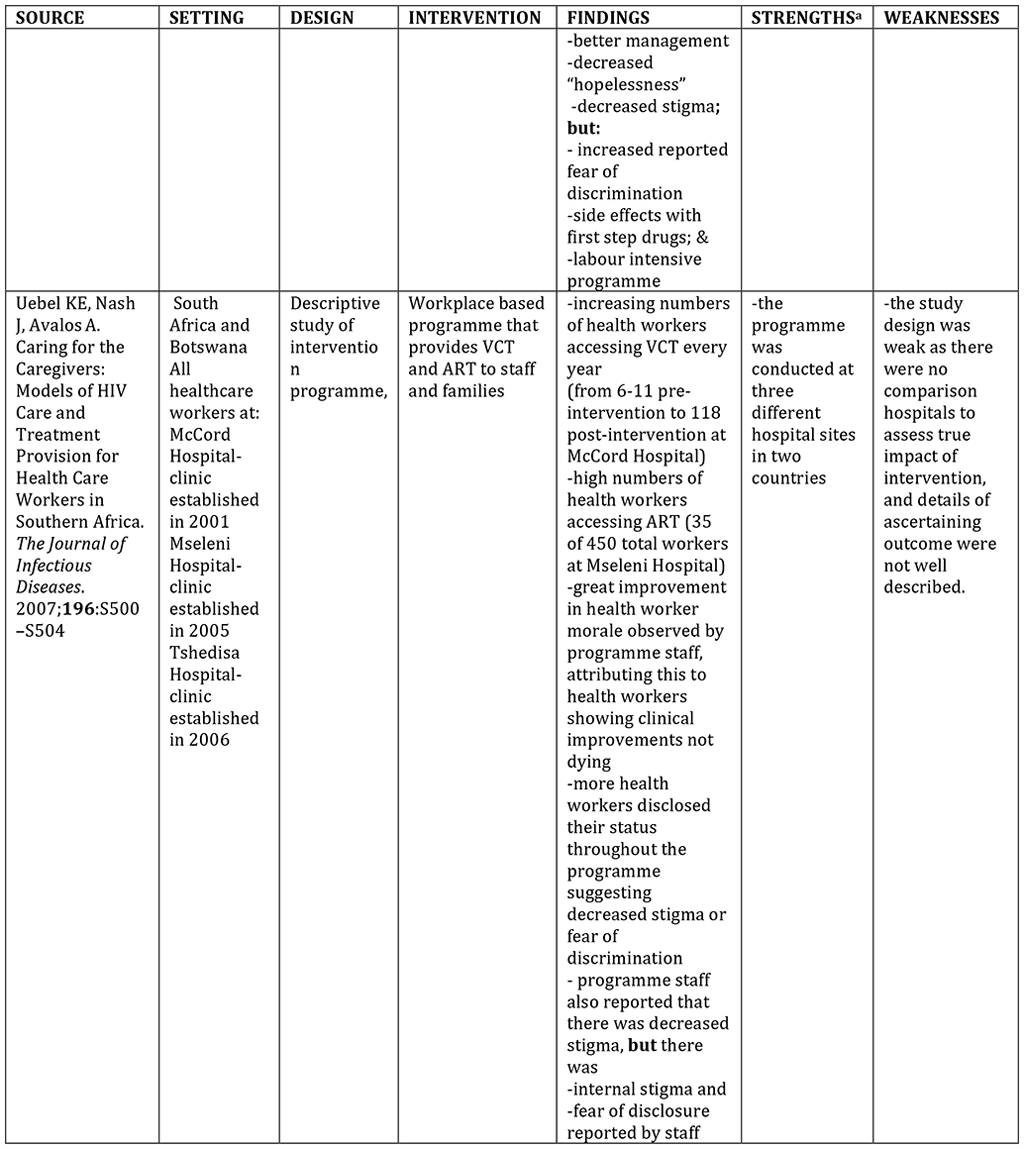Book traversal links for 2.1.1 Introduce new, or refine existing, national policies that ensure priority access for health workers and their families to services for the prevention, treatment and care for HIV and TB.
There are currently no existing guidelines that specifically address the issue of priority access for health workers to services for the prevention, treatment and care of HIV and TB, which, of course, is why the current Guidelines are needed. However, WHO documents do designate health workers as a high risk group (WHO, 2008) As noted in the Rationale for this Guideline, there is an abundance of evidence that HIV-infected health workers are at increased risk as a result of exposures they may confront in the course of their work. (e.g. Buve et al. 1994; Chanda at al. 2006; Corbett at al. 2007; Ekwueme et al. 2002; Harries et al. 2002 ;Joshi et al. 2006; Kassim et al. 2000; Kayanja et al. 2005; Pruss-Ustun et al. 2005; Sepkowitz 1994, and others.)
As also noted above, there is a crisis in health human resources wherein the recruitment and retention into health professions is not keeping pace with the need (Narasimhan 2004, Chen 2004) and there is a growing literature on the loss from the healthcare workforce due to HIV/TB.
Based on the evidence that health workers are at increased risk, as well as the evidence that there is serious need to ensure that health workers are not lost to the health workforce as a result of HIV and TB, some countries have indeed introduced national policies aimed to provide health workers with services that prevent occupational exposures to blood-borne and airborne diseases, and some have begun to introduce programmes to ensure not only prevention but priority access to diagnosis, treatment and care.
One example is the Employee Health and Wellness Strategic Framework for the Public Service (South Africa, 2008), which was developed in response to the WHO Global Plan of Action on Workers Health 2008-2017 and the ILO Decent Work Agenda in Africa 2007-2015. The document aims to integrate the quality of working life, well-being, and health and safety in order to build and maintain a healthy workforce for increased productivity and enhanced service delivery.
The Swaziland Comprehensive Wellness Centre Model established in 2006 by the Swaziland Nursing Association to address the issue of HIV among health workers is noteworthy. This programme, as described by Galvin and De Vries (2008), offers health and wellness services exclusively to health workers and their immediate families and highlights the fact that services for health workers must be comprehensive and accessible. A qualitative key informant study outlined potential barriers to HIV care among health workers, although no formal rigorous evaluation has yet been conducted.
In an attempt to delineate the most cost-effective manner of service provision for this target population, the study by Moodley and Bachmann (2002) found that the hospitals surveyed in South Africa that did in fact provide primary health care and the management of chronic illness as part of their occupational health services did not experience logistical or financial problems as a result. As discussed with respect to Statement #3, given the array of services that should be provided as part of an occupational health service, in which occupational health professionals provide primary, secondary and tertiary prevention of blood-borne and airborne diseases generally (e.g. hepatitis B and influenza.), the inclusion of HIV and TB prevention, treatment, care and support, should not provide a particular financial burden. As such the development of national policies to ensure priority access of health workers to services for the prevention, treatment and care of HIV and TB should be well-supported.
Findings from Corbett's 5-Country Study also support this statement namely that health facilities that observed better practices (the so-called "best practice" sites) reported lower death rates and more staff on ART than randomly selected sites. The study found that 95% of health workers welcomed annual testing for TB with a similar high proportion for HIV, and strongly supported doing so at their own facilities but often only when combined with priority access to ART for health workers. The study indeed also documented that health workers are deterred from accessing HIV services if they are forced to queue with the general population.
The 17-country survey found that health workers' access to HIV/TB free services is available in the same manner as the general population plus those specific to the workplace. However, currently priority access is mostly provided as a courtesy rather than provided as policy.
The issue of inclusion of immediate families was a main area of examination within these guidelines, as other than with respect to including case finding for TB, this area has not been addressed clearly in previous guidelines, and has not been rigorously studied. Galvin and De Vries (2008) noted:
" Most [participants] said that health workers had unstated arrangements of preferentially treating their colleagues' family members. It was not clear if this informal arrangement was seen as a burden or a benefit to providers. Sometimes this informal preference was limited if it was thought to be harmful to other patients—if there were already too many patients in line, or if helping the family member would anger the waiting patients."
This sentiment, and the existence of this informal "solution", was reiterated in other studies - suggesting the need for guidelines in the area. Moreover, with respect to best practices in the private sector (see Statement #8), the authors of evaluations of workforce programmes noted that reaching more spouses would improve overall utilization of the health benefits provided to employees and increase access to treatment. They suggested that treatment for a positive spouse is likely to help the support and adherence of the employee, and promote HIV prevention interventions.
Stenson and colleagues (2005) reporting on a workplace programme that did not provide coverage for families, (also described with respect to Recommendation #8) noted that:
Several health care providers and patients commented on the difficulties in this workplace programme associated with the lack of provision of ART to HIV-infected partners and children. This is a very real problem which may affect adherence, in addition to causing emotional and financial hardship. Availability of treatment for dependents is an important issue for all ART programmes. "Imagine, you ask a man to tell his wife that he is HIV positive, then when she also tests positive he must tell her that she cannot get any ART herself." (Senior Nurse)
The programme in Swaziland which provides comprehensive care to health workers off-site does provide comprehensive family coverage (Baleta 2008). No studies of this programme which met the inclusion criteria for the Cochrane-style review were found, hence, to follow the a priori protocol established for the Systematic Review were not included in this component of the evidence review. However, the recent Lancet commentary about this programme (Baleta 2008), an earlier article describing the programme (Galvin & De Vries 2008), and the evidence provided to the GG from the members of the GG who know the Swaziland programme well, were taken into consideration, and also included in the realist (narrative) review.
It is noteworthy that the ILO Code of Practice on HIV and the World of Work applies to workers and their families and the code states that: 'in light of the nature of the epidemic employee assistance programmes may need to be established or extended appropriately to include a range of services for workers as members of families, and to support their family members. This should be done in consultation with workers and their representatives, and can be done in collaboration with government and other relevant stakeholders in accordance with resources and needs' (section 9.8.)
As noted above, there is no universally accepted definition of "family". For purposes of these guidelines, "family" consists of depends and/or partners, and as noted above, these guidelines are meant to apply to immediate family members living in the household with the health workers. Dependent is defined as: a person married at law to the staff member; a person living as the partner of the staff member and not married at law to any other person; natural or adopted child—under 18 years of age or, if in full-time attendance at a school or university, under the age of 21 years—for whom the staff member certifies that he or she provides the main and continuing support; and/or a father, mother, brother or sister (not more than one such dependent may be claimed, and provided that the staff member is not married at law or living with a partner).In addition no distinction is to be drawn between adult and child dependents. Furthermore, partner means a relationship between two people, who are living with each other in a "community of life". In deciding whether a person is a "partner", the primary factor to be taken into consideration is the self-identification concerning the nature of the relationship. Additional factors which may be taken into consideration include: the length of the relationship; whether the people are residing together; whether there is, or has been, a sexual relationship between them; the degree of financial dependence or interdependence, and any arrangements for financial support between them; the ownership, use and acquisition of their property; the degree of mutual commitment by them to a shared life; whether they care for and support children; and public aspects of the relationship between them. As noted by the ILO Convention, the designation of inclusion criteria should be established at the regional or local level, in consultation with workers and their representatives, and in collaboration with government and other relevant stakeholders in accordance with resources and needs.
Thus, there is strong evidence that health workers are at additional risk due to their occupation. There is strong evidence that there is a world crisis in health human resources and that many healthcare workers are lost to the workforce as a result of HIV and TB._There is evidence that providing priority HIV and TB prevention, treatment and care for health workers can be readily accomplished without prohibitive cost, if provided within staff health services within healthcare facilities, assuming issues addressed in other statements (e.g. preventing discrimination and addressing stigma) are incorporated into national policy, and that the programmes are adequately supported by all stakeholders. Several countries have indeed introduced or strengthened national policies to ensure priority access for health workers to services for the prevention, diagnosis, treatment and care of HIV and TB. There are some national policies that are indeed exemplary, and finally some interventions providing priority access to health workers have been conducted, and the results were positive.
As such, the GG concludes that:
- Priority access must be a policy, and not simply a courtesy measure.
- The policy can be supported on the basis that there is overwhelming evidence that here is a crisis in health human resources creating an urgent need to recruit and retain health workers, combined with the overwhelming evidence that health workers are at greater risk of exposure, morbidity and mortality from HIV and TB compared to non-health workers.
- Priority access for health workers is hypothesized to reduce stigma overall, which can have a benefit to the population as a Whole.
- Some interventions providing priority access to health workers have been conducted, and the results were positive.
- There is some evidence that providing priority HIV and TB prevention, treatment and care for health workers can be readily accomplished without prohibitive cost, if provided within workplace health services within healthcare facilities, assuming issues addressed in other statements (e.g. preventing discrimination and addressing stigma) are incorporated into national policy ; evidence suggest that to be successful the programmes must be adequately supported by all stakeholders (e.g. including union, professional organizations and senior management), and involve committees of front-line (or peer) health workers in various aspects of the programme.
- Immediate household families of health workers should also be offered priority access to diagnosis (including VCT), HIV and case finding for TB; services. While this adds cost, and immediate family living in there is some debate regarding whether this will be perceived as unfair to families of non-healthcare workers, the same household as infected health workers should also be offered priority access to treatment.
- The inclusion of immediate families of health workers in line with the ILO code of practice on HIV and the world of work (section 9.8.)
- A representative of the national health department should be responsible for developing and implementing the national plan.



ᵃ A quality assessment was conducted of all the studies. As indicated by the WHO Handbook for Guideline Development, the decision as to whether the evidence is very strong, strong, etc. was discussed by the Guideline Group, as was the grading in this report. See Annex 4 for further details.
 Feedback
Feedback